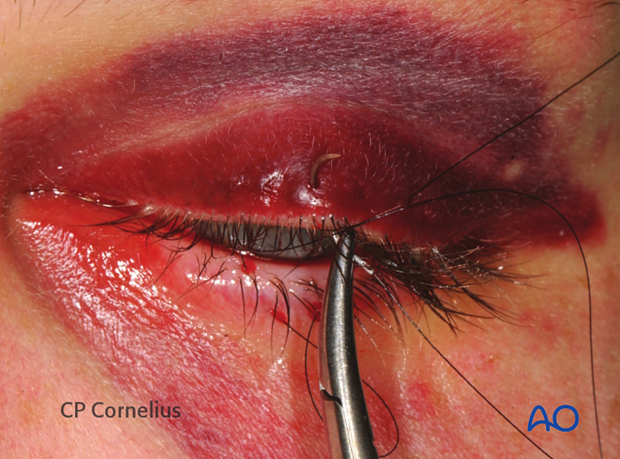Transcutaneous lower-eyelid approaches
1. Principles
There are three basic approaches through the external skin of the lower eyelid to give access to the inferior, lower medial, and lateral aspects of the orbital cavity:
- Subciliary (A, synonym: lower blepharoplasty)
- Subtarsal (B, synonym: lower or mideyelid)
- Infraorbital (C, synonym: inferior orbital rim)
The subciliary approach can be extended laterally to gain access to the lateral orbital rim (D).
The course of the incisions is aligned to the slope of the natural skin creases which become more apparent with age.
The skin of the eyelid is the thinnest in the human body. It has little or no dermis and almost no subdermal fat.
Hypertrophic scarring and keloid formation is very uncommon following lower lid skin incisions. In general, the scars become inconspicuous with time.

The approaches differ in the vertical position of the cutaneous incision lines. Because of this, the path and length of dissection through the layers of the lower lid vary.
Infraorbital incisions lie at the transition between the thin eyelid skin and the thicker cheek skin. They are therefore predisposed to edema and increased visibility of the scars, even when the incision runs curvilinear within the resting skin tension lines.
That is why the infraorbital approach has lost its former popularity. The infraorbital approach will not be detailed here.

Access areas
Transcutaneous lower-eyelid approaches yield pathways to the lower circumference of the orbital cavity and/or for the subperiosteal elevation of the upper midface and release of the cheek area.
The exposure of the infraorbital rim serves as the starting platform for the dissection of the periorbita.
The illustration outlines the approximate extent of the orbital bony surfaces which can be exposed via the subciliary, the subtarsal, and the infraorbital approach. There is little difference in the access areas along the floor, the medial and lateral rim, and the neighboring wall portions of the orbit.

With a lateral extension of the subciliary incision however, the entire lateral rim- with heavy traction even beyond the level of the zygomaticofrontal suture, as well the lateral orbital wall back to the zygomaticosphenoid suture become accessible.

Exposure of midfacial skeleton
This illustration shows the field of bone exposure inferomedial of the infraorbital rim and across the eminence of the zygoma that can be reached after release of the retaining ligaments and muscle attachments during periosteal undermining in a downward direction.
A connection with the surgical cavity created through the upper maxillary vestibular approach allows the dismantling of the whole lower and middle third of the midfacial skeleton.

2. Preparation – Corneal protection
For all three kinds of transcutaneous lower-eyelid incisions, a temporary tarsorrhaphy is recommended to help protect the cornea. This is done by employing a mattress suture.
A 6.0 suture is passed through the skin of the upper eyelid and exits through the Gray line of the upper lid margin.


In the lower eyelid the needle is passed from the Gray line into the skin where it exits.


The suture is guided back picking up the same soft-tissue portions in the lower and upper eyelid to complete the mattress loop.



The tarsorrhaphy is not tightly secured and some space is left between the knot and the upper-eyelid skin. A hemostatic clamp is used to grasp the suture and apply traction to lower lid for full eyelid closure during the surgical procedure.


Since the suture was not fully tightened, when the hemostatic clamp is released, the lid may be opened for a forced duction test or evaluation of the pupil during the procedure.


3. Link to transcutaneous lower-eylid approches described
Please choose one of the following transcutaneous lower-eylid approches to read a step-by-step description:
- Subciliary (A, synonym: lower blepharoplasty)
- Subtarsal (B, synonym: lower or mideyelid)
- Infraorbital (C, synonym: inferior orbital rim)
The subciliary approach can be extended laterally to gain access to the lateral orbital rim (D).














